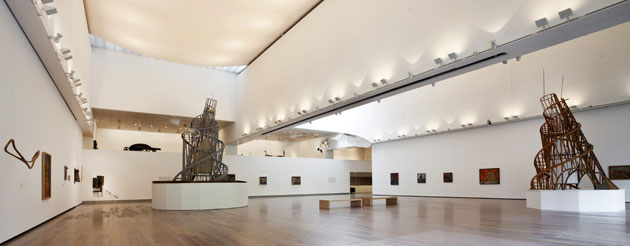This year the Museum Tinguely in Basel is dedicating its large summer exhibition to one of the most important figures of the Russian avant-garde: Vladimir Tatlin (1885–1953). It is now almost twenty years since the last comprehensive retrospective to be devoted to this radically innovative artist. The presented works will include early paintings, counter-reliefs that reach out into the surrounding space, reconstructions of his revolutionary tower, and the flying machine Letatlin. The exhibition is rounded off with examples of his work for the theatre. The œuvre of this outstanding artist from the watershed period at the beginning of the twentieth century will be represented in over one hundred masterpieces, mostly on loan from major collections in Moscow and St Petersburg.
Vladimir Tatlin began his career as a seaman. Until 1913 his artistic activities were limited exclusively to painting and drawing. Interested in the traditional fields of icon-painting and folk art, he later transferred his attention to the most modern avant-garde trends in Russia and Western Europe, more precisely Paris. His entire later work is founded on painting. The exhibition will show a comprehensive selection of his early paintings. With his painting Tatlin achieved a highly original synthesis of the Russian tradition and the French avant-garde.
Counter-reliefs
In the year 1914, Tatlin changed from being an avant-garde painter to being a revolutionary artist: there was already a sense of what was to come in 1917. Only little has been preserved of his painterly reliefs and the counter-reliefs. These works, produced before the October Revolution, constitute his most radical and far-reaching contribution to modern art. In the exhibition the few still existing originals from Moscow and St Petersburg are complemented with a representative selection of the reconstructions made on the basis of photographs, thus shedding light on this crucial aspect in the history of art. As Konstantin Umansky wrote in 1920, “Tatlinism” claimed that the picture as such was dead: “The flat canvas is too restricted for what is three-dimensional.”
Revolution, architecture and utopia – Tatlin’s tower
Few twentieth-century works of art have acquired such a legendary status as Tatlin’s projected Monument to the Third International of 1919–20, which was to have been 400 metres tall. For various reasons – Civil War, lack of material resources, and the technological limitations of the time – it was never realized. The monument – set parallel to the earth’s axis with four inner bodies rotating each on its own axis at various speeds in accordance with cosmological rhythms and laws – would have been the seat of the hierarchically and justly organized government of a new social order. The rotating spatial bodies of Tatlin’s “world machine” are indicative of revolution in both senses of the word. Tatlin’s tower project acted as a catalyst in the discussion conducted by figures such as Leon Trotsky and Anatoly Lunacharsky about how life, art and the state were to function in the young post-revolutionary Soviet Union; now it ranks as an inspirational and interpretational work of the highest order.
The flight of the Letatlin
The 1920s saw Tatlin engaging in a search for new dimensions in human flight. In 1929/32 he gave expression to the dreams of a collectively regulated society with his visionary flying machine Letatlin. With his strong penchant for mysticism, Tatlin considered that flying was a kind of primordial human experience lost in the course of evolution and wished to reappropriate it for modern man. Letatlin – a flying machine displaying a remarkable synthesis of art, technology and utopia – can be regarded as the culmination and end result of the exploration of the scope and limits of sculpture. However we interpret it, Tatlin’s dream of flying was to remain unfulfilled – even today, Letatlin has not yet left the ground.
The theatre as the stage of the new world
Tatlin had a life-long interest in theatre. Tatlin took its gripping musical sea- and soul-scapes and attempted to match them with a late Romantic Rayonist painted equivalent, taking tone colour and translating it into colour combinations full of drama and life. The peak of Tatlin’s creative work for the theatre came in 1923 with his staging of Velimir Chlebnikov’s futuristic super saga Zangezi.
Today Tatlin still retains his power to fascinate because his work was always done in the light of the total social context and with the intention of bringing about change. Furthermore, almost a century ago, he paved the way for currents that have still not lost their relevance and power to inspire in the field of contemporary art.
To see another illustration, click on Version Française, at the top of the page
| 








